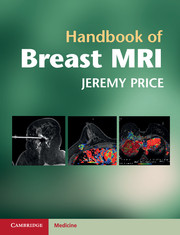Book contents
- Frontmatter
- Contents
- Preface
- Acknowledgements
- Glossary
- Abbreviations
- 1 Basics of breast MRI
- 2 Imaging-related anatomy and pathology
- 3 Interpreting breast MRI studies
- 4 MRI-guided biopsy techniques
- 5 High-risk screening using breast MRI
- 6 Preoperative staging with breast MRI
- 7 Problem-solving applications of breast MRI
- 8 MRI after breast augmentation
- Answers to multiple choice questions
- Appendices
- 1 Nephrogenic systemic fibrosis
- 2 Sensitivity and specificity
- 3 TNM classification
- 4 Overview of surgical procedures
- 5 Overview of radiation therapy
- 6 Overview of systemic therapy
- 7 Primary prevention strategies for high-risk women
- 8 Breast cancer genes and genetic testing
- Index
- Plate section
- References
8 - Breast cancer genes and genetic testing
Published online by Cambridge University Press: 05 March 2012
- Frontmatter
- Contents
- Preface
- Acknowledgements
- Glossary
- Abbreviations
- 1 Basics of breast MRI
- 2 Imaging-related anatomy and pathology
- 3 Interpreting breast MRI studies
- 4 MRI-guided biopsy techniques
- 5 High-risk screening using breast MRI
- 6 Preoperative staging with breast MRI
- 7 Problem-solving applications of breast MRI
- 8 MRI after breast augmentation
- Answers to multiple choice questions
- Appendices
- 1 Nephrogenic systemic fibrosis
- 2 Sensitivity and specificity
- 3 TNM classification
- 4 Overview of surgical procedures
- 5 Overview of radiation therapy
- 6 Overview of systemic therapy
- 7 Primary prevention strategies for high-risk women
- 8 Breast cancer genes and genetic testing
- Index
- Plate section
- References
Summary
BRCA1 and BRCA2
These two genes together account for 5–10% of all breast cancer cases in most populations [16]. Both the BRCA1 and BRCA2 gene mutations are autosomal dominant so that any first degree relative (mother, sister, daughter) of an affected individual has a 50% chance of also carrying the mutation. In the presence of a strong family history but no known mutation, genetic testing is usually considered when computer modeling programs such as BCRAPRO or BOADICEA suggest at least a 10–15% chance that a mutation is present. Young women with high-grade triple-negative cancers are often also tested for a possible BRCA1 mutation even in the absence of an extensive family history.
When a suspicious family history is found, the first step in genetic testing is to take blood from an affected family member. This sample is subjected to full genetic testing for all known mutations of the BRCA1 and BRCA2 genes (about 2000 for each). Although expensive and time-consuming, the results often facilitate management of the entire family, because if a pathogenic mutation such as BRCA1 is identified, the remaining members of the family can then be offered predictive testing for that specific mutation, which is both quicker and less expensive.
- Type
- Chapter
- Information
- Handbook of Breast MRI , pp. 202 - 203Publisher: Cambridge University PressPrint publication year: 2011



